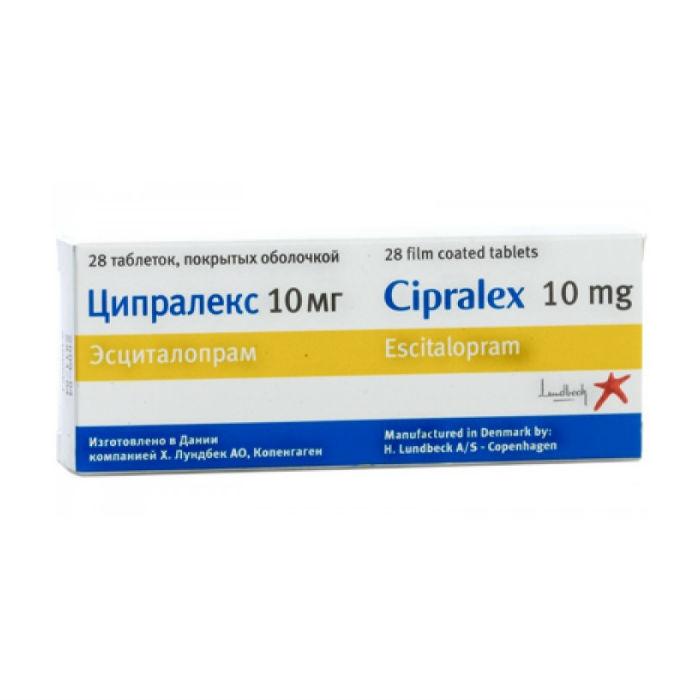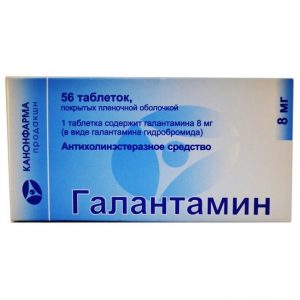Description
Release form
coated tablets
Packing
28 pcs.
Pharmacological action
Cipralex – antidepressant, selective serotonin reuptake inhibitor.
Inhibition of serotonin reuptake leads to an increase in the concentration of this neurotransmitter in the synaptic cleft, enhances and prolongs its effect on postsynaptic receptor sites.
Escitalopram does not have or has very poor ability to bind to a number of receptors, including: serotonin 5-HT1A, 5-HT2 receptors, dopamine D1 and D2 receptors, a1-, a2-, b-adrenergic receptors, histamine H1 receptors, m-cholinergic receptors, benzodiazepine and opioid receptors.
Indications
Depressive episodes of any severity
Panic disorder with / without agoraphobia
Contraindications
Concomitant use of MAO inhibitors
Pregnancy
Lactation (breastfeeding)
Children under 15 years of age
Hypersensitivity to escitalopram and other components of the drug.
Use during pregnancy and lactation
Cipralex is contraindicated in pregnancy and lactation (breastfeeding).
Special instructions
Escitalopram cannot be prescribed simultaneously with MAO inhibitors. Escitalopram can be prescribed 14 days after discontinuation of treatment with irreversible MAO inhibitors and at least 1 day after discontinuation of therapy with reversible MAO inhibitors of type A (including moclobemide). At least 7 days should elapse after escitalopram is taken before treatment with non-selective MAO inhibitors can begin.
Some patients with panic disorders may experience increased anxiety at the beginning of treatment with selective serotonin reuptake inhibitors (including escitalopram). Such a paradoxical reaction usually disappears within 2 weeks of treatment. To reduce the likelihood of an anxiogenic effect, it is recommended to use the drug in low initial doses.
Escitalopram should be discontinued if convulsive seizures develop. The use of the drug in patients with unstable epilepsy with controlled seizures is not recommended, careful monitoring is necessary. With an increase in the frequency of seizures, selective serotonin reuptake inhibitors, including escitalopram, must be discontinued.
With caution, escitalopram should be used in patients with a history of mania / hypomania. With the development of the manic state, escitalopram must be canceled.
When treating patients with diabetes with escitalopram, a change in blood glucose is possible. Therefore, dose adjustment of insulin and / or oral hypoglycemic drugs may be required.
Clinical experience with escitalopram and other selective serotonin reuptake inhibitors indicates a possible increased risk of suicide in the first weeks of therapy. Careful monitoring of patients during this period is important.
Hyponatremia, possibly associated with impaired ADH secretion, rarely occurs with escitalopram and usually disappears when therapy is discontinued. With caution, escitalopram and other selective serotonin reuptake inhibitors should be prescribed to patients at risk of developing hyponatremia: the elderly, patients with cirrhosis and taking drugs that can cause hyponatremia.
When taking escitalopram, skin hemorrhages (ecchymosis and purpura) may develop.
It is necessary to use escitalopram with caution in patients with a tendency to bleeding, as well as taking oral anticoagulants and drugs that affect blood coagulation.
The clinical experience with escitalopram in combination with electroconvulsive therapy is limited, so caution should be exercised in this case.
The simultaneous use of escitalopram and type A MAO inhibitors is not recommended due to the risk of developing serotonin syndrome.
In patients taking escitalopram and other selective serotonin reuptake inhibitors concurrently with serotonergic drugs, in rare cases, serotonin syndrome may develop.
It is necessary to use escitalopram with caution simultaneously with drugs with serotonergic effects. The combination of symptoms such as agitation, tremor, myoclonus, hyperthermia, may indicate the development of serotonin syndrome. If this happens, selective serotonin reuptake inhibitors and serotonergic drugs should be immediately withdrawn and symptomatic therapy prescribed.
Concomitant use of escitalopram and alcohol is not recommended.
Influence on the ability to drive vehicles and control mechanisms
Although escitalopram does not affect psychomotor activity, it is not recommended to drive a car or mechanisms during treatment.
Composition
1 tablet comprising escitalopram (as oxalate) 10 mg
Dosage and administration
Cipralex is prescribed 1 time / day, regardless of food intake.
In depressive episodes, the drug is usually prescribed at a dose of 10 mg / day. Depending on the individual reaction of the patient, the dose can be increased to a maximum of 20 mg / day.
The antidepressant effect usually develops 2-4 weeks after the start of treatment. After the symptoms of depression disappear for at least another 6 months, therapy should be continued to consolidate the effect.
For panic disorders with / without agoraphobia, a dose of 5 mg / day is recommended during the first week of treatment, followed by an increase to 10 mg / day. Depending on the individual reaction of the patient, the dose can be increased to a maximum of 20 mg / day.
The maximum therapeutic effect is achieved approximately 3 months after the start of treatment. Therapy lasts several months.
In elderly patients (over 65 years), it is recommended to use half of the usually recommended dose (i.e. only 5 mg / day) and a lower maximum dose (10 mg / day).
In renal failure of mild to moderate severity, dose adjustment is not required. Patients with severe renal failure (CCP patients with impaired liver function, the recommended initial dose for the first 2 weeks of treatment is 5 mg / day. Depending on the individual response to treatment, the dose may be increased to 10 mg / day.
With reduced activity of the CYP2C19 isoenzyme, the recommended starting dose for the first 2 weeks of treatment is 5 mg / day. Depending on the individual response to treatment, the dose may be increased to 10 mg / day.
When discontinuing treatment with Cipralex, the dose should be reduced gradually over a period of 1-2 weeks to avoid the development of withdrawal syndrome.
Side effects of the
Digestive system:
The most common are nausea, loss of appetite, diarrhea, constipation
Rarely – disturbances in taste are possible – vomiting, dry mouth, changes in laboratory parameters of liver function.
From the side of the central nervous system and peripheral nervous system:
Most often – insomnia or drowsiness, dizziness, weakness
Possible – visual disturbances, seizures, tremors, motor disorders, serotonin syndrome, hallucinations, mania, confusion, agitation, anxiety, depersonization panic attacks, increased irritability
From the side of metabolism:
Most often – increased sweating, hyperthermia
Perhaps – hyponatremia
From the reproductive system: Most often – decreased libido o, impotence, violation of ejaculation, anorgasmia (in women).
From the cardiovascular system: Orthostatic hypotension is possible.
From the endocrine system: possibly – insufficient secretion of ADH, galactorrhea.
Allergic reactions: possibly anaphylactic reactions, angioedema.
Dermatological reactions: possibly – skin rash, itching, ecchymosis, purpura.
Other:
Most often – sinusitis
Possibly arthralgia, myalgia, urinary retention
With abrupt withdrawal of the drug after prolonged use, withdrawal reactions may occur – dizziness, headaches and nausea. The severity of these reactions is negligible, and the duration is limited.
Side effects most often develop at 1 or 2 weeks of treatment and then usually become less intense and occur less frequently with continued therapy.
Drug Interactions
Pharmacodynamic Interactions
With the simultaneous use of Cipralex with MAO inhibitors, as well as with the start of taking MAO inhibitors in patients who shortly before stopped taking Cipralex, serious adverse reactions may occur. In such cases, serotonin syndrome may develop.
The combined use of Cipralex with serotonergic drugs (for example, tramadol, sumatriptan and other triptans) can lead to the development of serotonin syndrome.
Cipralex may lower the seizure threshold. Caution is necessary with the simultaneous administration of Cipralex and other drugs that lower the threshold of convulsive readiness.
Since cases of increased effect have been reported with the combined administration of Cipralex and lithium or tryptophan, caution is advised when taking these drugs at the same time.
The simultaneous administration of Cipralex and drugs containing St. John’s wort (Hypericum perforatum) can lead to an increase in the number of side effects.
When prescribing escitalopram with oral anticoagulants and drugs that affect blood coagulation (for example, atypical antipsychotics and phenothiazines, most tricyclic antidepressants, acetylsalicylic acid and NSAIDs, ticlopidine and dipyridamole) bleeding disorders may occur. In such cases, at the beginning or at the end of escitalopram therapy, careful monitoring of blood coagulation is necessary.
While taking alcohol, escitalopram does not enter into pharmacodynamic or pharmacokinetic interaction. However, as with other psychotropic drugs, the simultaneous use of escitalopram and alcohol is not recommended.
Pharmacokinetic interaction
Co-administration with drugs that inhibit the CYP2C19 isoenzyme may increase the concentration of escitalopram in the blood plasma. With caution, escitalopram should be used simultaneously with similar drugs (including with omeprazole), a dose reduction of escitalopram may be required.
Caution is advised to prescribe Cipralex in high doses at the same time as cimetidine in high doses, which is a potent inhibitor of the isoenzymes CYP2D6, CYP3A4 and CYP1A2.
Escitalopram is an inhibitor of the CYP2D6 isoenzyme. Caution must be exercised while prescribing escitalopram and drugs that are metabolized with this isoenzyme and have a low therapeutic index, for example, flecainide, propafenone and metoprolol (in cases of heart failure) or drugs that are mainly metabolized through the CYP2D6 isoenzyme and acting on the central nervous system for example antidepressants desipramine, clomipramine, nortriptyline or antipsychotics risperidone, thioridazine, haloperidol. In these cases, a dose adjustment may be required.
The simultaneous administration of escitalopram and desipramine or metoprolol leads to a twofold increase in the concentration of the last two drugs.
Escitalopram may slightly inhibit the CYP2C19 isoenzyme. Therefore, caution is advised while using escitalopram and drugs metabolized with the participation of this isoenzyme.
Overdose
Symptoms: dizziness, tremor, agitation, drowsiness, darkness of consciousness, seizures, tachycardia, ECG changes (change of ST segment and tooth T, widening of QRS complex, lengthening of QT interval, arrhythmia , metabolic acidosis, hypokalemia.
Treatment: No specific antidote exists. Treatment is symptomatic and supportive: gastric lavage, adequate oxygenation. Monitoring of cardiovascular and respiratory function.
Storage Conditions
The product should be stored at a temperature not exceeding 25 ° C.
Shelf life
3 years.
Deystvuyushtee substance
stsitalopram
Dosage form
tablets
Possible product names
Cipralex tablets 10 mg, 28 pcs.
Cipralex tablets 10 mg 28 pcs.
CIPRALEX 0.01 N28 TABLE P / O
Cipralex 10mg Tab. p / o X28 /! up to 10.10g /
Tsipralex 10mg Tab. poststation X28 / until 05.08 g / (R)




